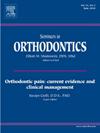Biocreative clear expander: An effective slow expansion device for correcting maxillary transverse deficiency
IF 2.2
4区 医学
Q2 DENTISTRY, ORAL SURGERY & MEDICINE
引用次数: 0
Abstract
Maxillary expansion is crucial for correcting transverse maxillary deficiencies and aligning arch width discrepancies between the maxilla and mandible. Although rapid maxillary expansion (RME) achieves faster skeletal changes, it can lead to adverse effects such as excessive tipping, root resorption, and residual stress, primarily due to the higher force levels applied. In contrast, slow maxillary expansion (SME) facilitates gradual physiological adaptation with a balanced ratio of skeletal-to-dental changes, reduced relapse rates, and a lower incidence of tissue damage. When selecting a maxillary expansion technique, patient-specific factors, including age, growth potential, and cooperation tolerance should be considered. The biocreative clear expander (Clex) is an effective SME device that offers stable and uniform expansion forces across the maxilla while minimizing individual tooth movement, reducing interference with mandibular motion, and enhancing oral hygiene due to its removability. However, further studies are required to evaluate the long-term retention and maintenance effects. This report presents two patients who were successfully treated with a biocreative clear expander.
求助全文
约1分钟内获得全文
求助全文
来源期刊

Seminars in Orthodontics
DENTISTRY, ORAL SURGERY & MEDICINE-
CiteScore
2.20
自引率
4.80%
发文量
28
审稿时长
10 days
期刊介绍:
Each issue provides up-to-date, state-of-the-art information on a single topic in orthodontics. Readers are kept abreast of the latest innovations, research findings, clinical applications and clinical methods. Collection of the issues will provide invaluable reference material for present and future review.
 求助内容:
求助内容: 应助结果提醒方式:
应助结果提醒方式:


